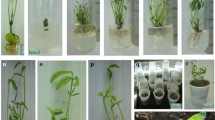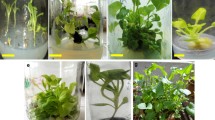Abstract
The effects of growth regulators on callus induction and direct shoot induction which derived from meristem culture in length of 0.3, 0.5, 0.7 mm were studied in 12 cultivars of sugarcane. Calli induction in all cultivars were occurred from meristem after culturing onto solid Murashige and Skoog’s (MS) medium containing 3 mg/l 2,4-0 and 10% coconut water (by volume) for 2 months, while direct shoots occurrence was induced from each meristem (0.5 - 0.7 mm in length) in liquid MS medium containing 0.2 mg/l benzyladenine (BA) and 0.02 mg/l napthalene acetic acid (NAA). Calli could differentiate into shoots and developed to plantlets on MS media at reduced concentration of 2, 4-D to 1 mg/l for 2 months of culture. The plantlets were cultured on solid MS medium containing 0.08 mg/l adenine sulfate, 2 mg/l kinetin, 1 mg/l indole butyric acid (IBA) and 10% coconut water for tiller stimulation. An average of 11 shoots/ plantlet were obtained in 2 months. About 80 - 100% of sugarcane plantlets derived from meristem culture of each sugarcane cultivar were free of sugarcane mosaic virus (SCMV) as determined by enzyme-linked immunosorbent assay (ELISA). Plantlets were transferred to MS media containing 4.5% sucrose for root induction and transplanting into soil. Mass propagation and virus-free sugarcane germplasm can be produced by these methods.
Similar content being viewed by others
References
Ammirato, P.V. (1986). Control and expression of morphogenesis in culture.In : Plant tissue culture and its agricultural applications. LA. Withers and P.G. Alderson (eds). p. 23–45.
Clark, M.F. and Adams, A.N. (1977). Characteristics of the microplate method of enzyme-linked immunosorbent assay for the detection of plant virus. J. Gen. Virol.,34: 475–483.
Dean, J.L. (1982). Failure of sugarcane mosaic virus to survive in cultured sugarcane tissue. Plant Disease,66: 1060–1061.
Flick, C.E., Evans, D.A. and Sharp, W.R. (1983). Organogenesis. p. 13–81.In: Handbook of plant cell culture. Volume 1. D.A. Evans, W.R. Sharp, P.V. Ammirato and Y. Yamada (eds), Macmillan, New York.
Futrakul, A. (1989). Serological method for the detection of sugarcane mosaic virus in sugarcane callus and plantlet derived from tissue culture. MS Thesis, Kasetsart University, Thailand. 85 pp.
Hendre, P.R., Mascarenhas, A.F., Nadgir, A.L., Pathab, M. and Pagahathan, V. (1975). Growth of mosaic-virus-free sugarcane plants from apical meristems. Indian Phytopathol.,28: 175–178.
Langhans, R.W., Horst, R.K. and Eark, E.D. (1977). Disease-free plants via tissue culture propagation. Hort. Science,12: 149–150.
Leu, L.S. (1972). Freeing sugarcane from mosaic virus by apical meristem culture and tissue. Taiwan Sugar Exp. Stn. Rept.,57: 57–63.
Maretzki, A. and Hiraki, P. (1981). Sucrose promotion of root formation in plantlets regenerated from callus ofSaccharum spp. Hort. Abst,51: 758.
Mellore, F.C. and Stace-Smith, R. (1977). Virus-free potatoes by tissue culture, p. 616–635. In J. Reinert and Y.P.S. Bajaj (eds.) Plant cell, tissue and organ culture. Springer-Verlag, Berlin.
Murashige, T. and Skoog, F. (1962). A revised me- dium for rapid growth and bioassays with tabacco tissue cultures. Plant Physiol.,15: 473–497.
Nadar, H.M., Soepraptapo, S., Heinz, D.J. and Hadd, S.L. (1978). Fine structure of sugarcane (Saccharum sp.) callus and the role of auxin in embryogenesis. Crop Sei.18: 210–216.
Pierik, R.L.M. (1987). Vegetative propagation. In :In vitro culture of higher plants, p. 183–230. Martinus Nijhoff Publishers, Netherlands.
Quak, F. (1977). Meristem culture and virus-free plant, p. 598–615. In: J. Reinert and Y.P.S. Bajaj (eds). Plant cell, tissue and organ culture, Springer Verlag, Berlin.
Skoog, F. and Miller, C.O. (1957). Chemical regulation of growth and organ formation in plant tissue, Symp. Soc. Exptl. Biol.,11: 118–131
Scully, R.M. (1967). Aspects of meristem culture in Cattleya alliance. Amer. Orchid Soc. Bull.,36: 103–108.
Thiamann, K.V. (1977). Apical dominance, p. 289–326. In : Hormone action in the whole life of plants, University of Massachusett Press, USA.
Author information
Authors and Affiliations
Corresponding author
Rights and permissions
About this article
Cite this article
Visessuwan, R., Chiemsombat, P., Naritoom, K. et al. Role of growth regulators in meristem culture and production of virus-free sugarcane germplasm. Sugar Tech 1, 82–88 (1999). https://doi.org/10.1007/BF02945168
Published:
Issue Date:
DOI: https://doi.org/10.1007/BF02945168




